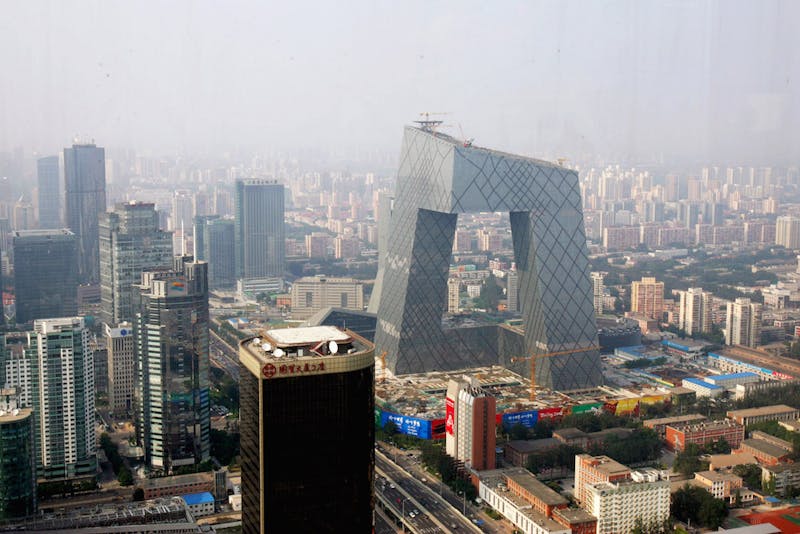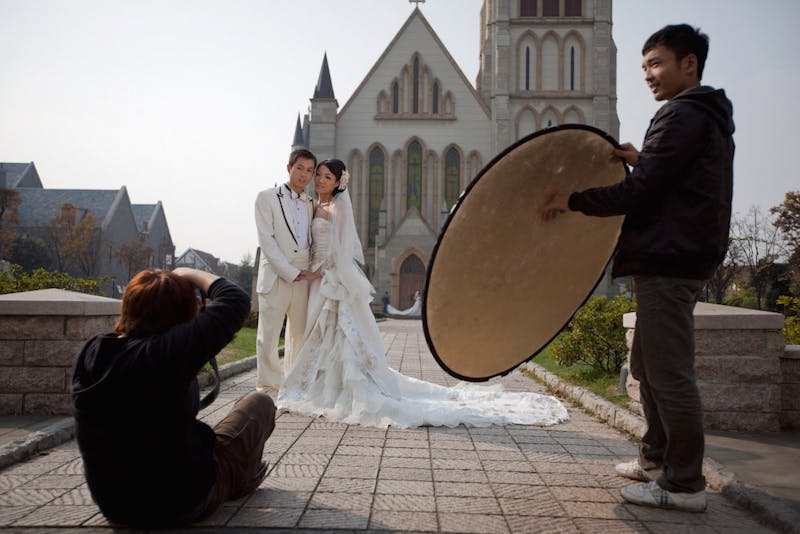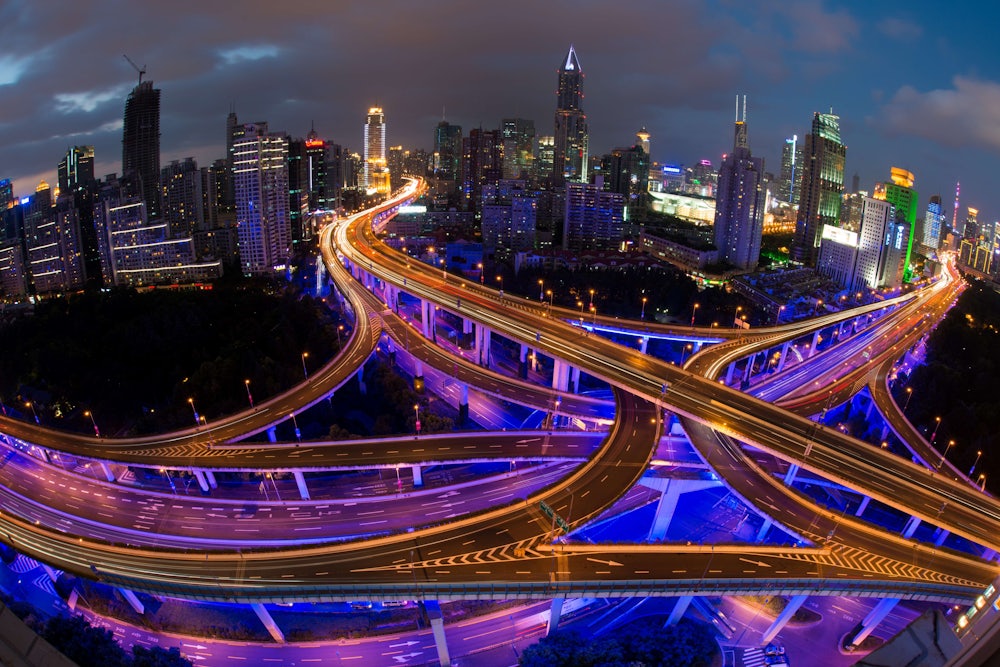Visitors who travel to the Minhang People’s Court in Shanghai will find themselves staring up at the U.S. Capitol building. This courthouse, like half a dozen others around China, is an almost exact replica of the Washington, D.C. landmark, with a few flourishes cribbed from the White House. It is a short distance away from Thames Town, a British-themed gated community built for 10,000 people, complete with a cathedral copied from Bristol, England. And from there, it’s an easy trip to “the boot”—locals’ ungenerous nickname for LVMH’s sparkling headquarters, which towers over the city like a white shoe.
China has long been ground zero for daring and sometimes bizarre architecture executed at a scale and speed that would be impossible anywhere else. City skylines have come to resemble a trophy case of architectural marvels: There is a teapot-shaped museum in Zunyi, a stock exchange modeled after a coin in Guangzhou, a copycat Venice complete with canals in Hangzhou, and, in the capital, the $900 million Rem Koolhaas-designed CCTV tower, which Beijingers derisively refer to as the “giant trousers.”

These eye-catching edifices began as China’s way of announcing its arrival as a powerful player on the world stage. Now, however, the Chinese government has changed course: It has officially declared this to be “weird” architecture that must be stopped. Chinese leaders have turned their backs on these structures, a shift that underscores China’s new conception of itself and its ambitions for the future.
This month, China’s cabinet and the Central Committee of the Communist Party released a sweeping directive that prohibits the construction of “oversized,” “xenocentric,” and “weird” architecture lacking “cultural tradition.” The guidelines also forbid gated communities—presently the de facto template for upscale residential compounds—and call for future building designs to be “suitable,” “economical,” “green,” and “pleasing to the eye.”
China Daily, a state-run newspaper, trumpeted the guidelines as measures to address mounting urbanization woes, including the snarled traffic jams and noxious smog that have plagued cities as their populations have swelled.
But the government’s mandate explicitly addresses both the function and form of new buildings, and the planning imperative seems designed to go beyond improving the quality of life. The end of “weird” architecture ties in to the government’s recent efforts to champion frugality, revive traditional values, and keep foreign ideas at bay—priorities that have assumed even greater importance in the midst of China’s ongoing corruption crackdown and fears of an economic slowdown.
The Chinese Communist Party has always been keenly aware of the propaganda value of architecture. In the 1950s and 1960s, following Mao’s rise to power, bureaucrats took wrecking balls to traditional homes under the rationale that the nation needed new buildings to match its fresh ideology. The old structures were replaced with Soviet-style apartment blocks, wide boulevards, and imposing halls that embodied the socialist spirit. “National form, socialist content” became the planning motto of the day.
A few decades later, the 2008 Summer Olympics—China’s coming out party as a global leader—proved a boom time for “weird” architecture, as bureaucrats rushed to approve starchitects’ expensive and impressive designs for buildings that could double as monuments to China’s superpower status. Pritzker-prize winning architects like Jean Nouvel, Jacques Herzog, Pierre de Meuron, and Zaha Hadid all won major commissions. Since 2005, Hadid alone has been awarded more than ten projects throughout China (not including a knock-off of her design built in Chongqing). Meanwhile, in the suburbs, local officials chose to house their headquarters in iconic buildings evoking power and prestige: the U.S. Capitol, the White House, even the Palace of Versailles.

Of course, it can be easy to mock piano-shaped museums and Eiffel Tower replicas. (When I wrote a book, Original Copies, on China’s “duplitecture,” people demanded to know why I would dedicate time to this “kitschy,” “unimaginative” form of “trash” design.) The strange buildings do have their redeeming qualities, however. Counterintuitively, though many of the structures look Western, the conditions that gave rise to them are uniquely Chinese—including China’s distinct philosophy on copying, which has traditionally been more nuanced and permissive than the West’s. They reflect a specific time in China’s post-reform evolution, when the country was grappling with how to assert itself. And they evoke the minor but significant liberties that the government is now poised to claw back. Architecture was strictly Soviet and tightly controlled under previous regimes. These “weird” buildings are testaments of the freedom people have had, for the first time in a generation, to experiment with design and, in the domestic sphere, see individual fantasies become reality.
Today, the state’s priorities have shifted yet again. Deng Xiaoping’s maxim, “To get rich is glorious,” has been replaced by President Xi Jinping’s command to bring “honor to frugality and shame to extravagance.” The decision to outlaw “odd-shaped” buildings suggests an effort to solidify China’s war on luxury in concrete and stone. The gated communities the government aims to eliminate—well-manicured compounds that look like oases against the nation’s industrial landscape—have sequestered the upper- and middle-classes behind layers of fences and security guards. They are stark reminders of China’s growing income inequality and run counter to the socialist ideals Xi has stressed. Not only will these isolated and ostentatious developments be banned in the future, but existing gated communities will be opened to the public.
At the same time, the government’s mandate seeks to shift construction methods over the next ten years to ensure that by 2026, at least 30 percent of new buildings will rely on prefabrication. The policy promises to flatten the differences between buildings and bring a more uniform appearance to China’s cityscapes, one that harkens back to the Mao era, when design was considered an unnecessary extravagance. (It remains to be seen whether this will apply to private homes, as well.)
The latest directive also reflects China’s renewed wariness of Western ideas. More than past leaders, Xi has turned toward nationalism and encouraged China to reconnect with traditional values as a way, some speculate, to combat the cash-centric mindset that has contributed to corruption. “We should be more respectful and mindful of 5,000 years of continuous Chinese culture,” Xi declared in a 2014 address to the Politburo. This month’s push to block architecture devoid of “cultural tradition” echoes Xi’s exhortation to artists, in another 2014 speech, to “disseminate contemporary Chinese values” and “embody traditional Chinese culture” in their art. Architecture is apparently no exception.
But the government’s new approach to its skyline is more than an attempt to celebrate the nation’s cultural heritage, or make a few aesthetic tweaks. Instead, it represents a shift in how China conceives of its place relative to other global superpowers. With design stunted under Mao and planners racing to accommodate an influx of urbanites, developers in the 1990s and early 2000s eagerly tapped foreign architects in the hopes of absorbing their technical expertise. In its justification for building Thames Town in 2001, for example, the Shanghai Urban Planning Bureau stressed the opportunity to “learn from international experience,” then use it to China’s advantage. (The project was completed by a British firm.) Now, the buildings that grew out of these collaborations are being dismissed as “weird” and “xenocentric.”
The government’s reversal on architecture thus seems to contain a larger message about how it views China’s development: The nation has surpassed the need for foreign input, and knows better than outsiders how to conduct its own affairs. China will lead, not follow.
A photo caption in this article previously stated that CCTV headquarters are in Shanghai; they are in Beijing.
